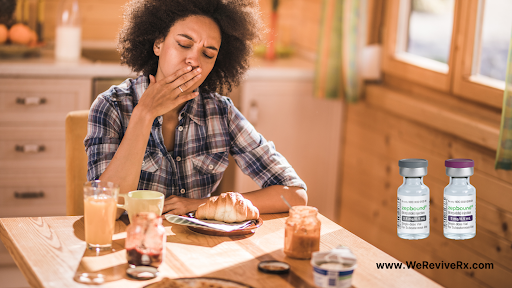Zepbound and Nausea: How to Manage It
Zepbound and Nausea: How to Manage It

Introduction
Nausea is one of the most common (and annoying) side effects of starting Zepbound. While it often fades after the first few weeks, it can feel uncomfortable and discouraging at first.
In this blog, we’ll explain why Zepbound causes nausea, when it typically peaks, and the most effective ways to prevent and manage it—so you can stay consistent with your weight loss journey.
Why Does Zepbound Cause Nausea?
Zepbound (tirzepatide) works by mimicking the hormones GLP-1 and GIP, which:
- Slow gastric emptying
- Suppress appetite
- Enhance insulin response
This slowed digestion is great for weight loss—but can also cause:
- Food to “sit” longer in the stomach
- A feeling of fullness, queasiness, or bloating
- Occasional vomiting (in rare cases)

How Common Is Nausea on Zepbound?

- 12–18% of users reported nausea
- It was usually mild to moderate
- Most cases resolved within 4–6 weeks
You’re more likely to feel nauseous if:
- You increase your dose too quickly
- You eat large, heavy meals
- You skip meals and then eat too much at once
- You’re dehydrated
What Zepbound-Related Nausea Feels Like





Tips to Prevent Nausea on Zepbound
 1. Eat Small, Frequent Meals
1. Eat Small, Frequent Meals
Avoid skipping meals. Instead:
- Have 3 small meals + 1–2 light snacks daily
- Stick with easy-to-digest foods
 2. Don’t Overeat
2. Don’t Overeat
Stop eating at 80% full, even if you didn’t finish your plate.
 3. Choose the Right Foods
3. Choose the Right Foods
Focus on:
- Lean protein (chicken, eggs, yogurt)
- Low-fat foods
- Broth-based soups, oatmeal, rice, bananas
Avoid:
- Fried or greasy meals
- Spicy foods
- Carbonated beverages or artificial sweeteners (can bloat)
 4. Stay Hydrated
4. Stay Hydrated
Sip water, herbal tea, or electrolyte drinks throughout the day.

 5. Time Your Dose Smartly
5. Time Your Dose Smartly
Many users feel better when they inject:
- Right before bed, or
- In the morning after a light breakfast
Try both to see what works for you.
What Helps if You’re Already Nauseous?

- Saltine crackers or toast
- Sipping ginger ale or mint tea
- Lying down in a quiet, cool room
- Taking deep breaths or using a cold compress on your neck
- Motion sickness bands (acupressure) for natural nausea relief

- Zofran (ondansetron)
- Pepcid (famotidine)
- Meclizine or Dramamine
When to Call Your Doctor
Contact your provider if:
- Nausea is constant or severe
- You’re vomiting more than once a day
- You can’t keep down food or fluids
- You lose more than 5–10 lbs in a week due to nausea

Final Thoughts
Nausea is common but manageable, especially if you’re proactive. Most users adjust within a few weeks and experience less nausea with each new dose. Be patient—and give your body time to catch up with your progress.





